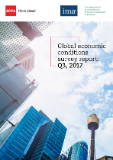The third report in 2017 from our joint global survey with IMA shows that economic confidence show another slight improvement and the first sustained period of growth since the financial crisis.

Economic confidence improved slightly in the third quarter of 2017, and is now at its second highest level in over two years. The findings of the latest Global Economic Conditions Survey (GECS) are consistent with other data, such as the PMIs, which suggest that the global economy is enjoying a strong recovery.
South Asia was the third quarter’s most confident economic region, followed closely by Africa and Asia Pacific.
Confidence levels were most depressed in Central and South America. Confidence in North America fell for the second consecutive quarter in Q3, and the number of people feeling less confident about the future exceeds those feeling more confident – the first time this has been the case since the third quarter of 2016. Having been the most confident region in Q2, North America has now slipped to fourth place.
Economic confidence rebounded strongly in the UK, but it remains low by historical standards. This suggests that while investors are starting to put the uncertainty generated by June’s inconclusive election result behind them, confidence is still inhibited by other factors – Brexit in particular.
As with the past couple of quarters, the biggest worry for survey respondents was rising costs in terms of both wages and raw materials; this was an issue for 49% of respondents. Second on the list was falling incomes, followed by concerns about securing prompt payment. The lowest level of concern was about suppliers going out of business, which, against the backdrop of a gradually improving global economy, is perhaps understandable.
The opportunity to explore lowering costs was the main positive development mentioned by respondents to the survey, followed by the opportunity to benefit by focusing on innovation. Lowest on the list, and mentioned by just 15% of respondents, was the opportunity to increase orders, which suggests challenges for future demand.


